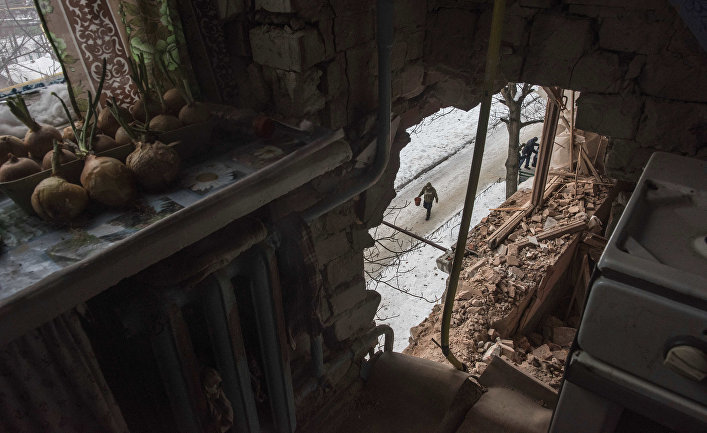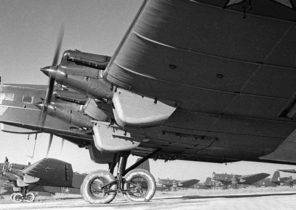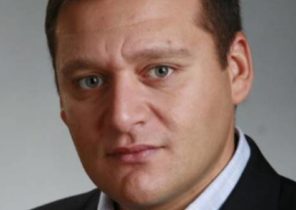
In the Ukrainian city of Avdeevka after weeks of attacks from the side controlled by the separatists Donetsk lull. Repair crews managed to restore electricity supply in most areas and at Avdiivka coke plant that provides the city with heat. Ukrainian authorities and volunteers summarize the weekly nightmare: from three to eight dead civilians, one dead and three injured emergency workers, wounded a British journalist, more than 170 of destroyed and damaged homes — not counting military casualties.
Day 2 Feb British photographer Christopher Nunn sat in the kitchen in an ordinary apartment panel houses built in Soviet times. In the morning of the same day along with his friend, performed the role of an interpreter and a driver named Vladimir, Nunn came to town, which for several days had been under intense shelling by the located within 20 kilometers of Donetsk. The Briton got here to convey medicines to the local hospital to walk around town, talk to its inhabitants and, of course, make pictures. What happened then, Nunn has described in his Instagram in the comments to the pictures where taken the same kitchen.
“The city is already a few days living without electricity and heat. On the outskirts were heard artillery fire, but nothing too serious happened. In the evening we went to visit Elena, a good friend of friends, to see how she lives under the circumstances. We had a little snack and drank tea, sitting around the kitchen table. Gradually the sound of artillery fire became more frequent and came closer — however, according to Elena, who has lived in the town throughout the war, this was nothing unusual.
Suddenly, the wall next to the kitchen window was hit by a rocket (it turned out later that we are talking about mortar shells, — Radio Liberty). I was already in the bedroom. The blast threw the shards of the window glass in my face, one of the shards hit me in the left eye. Vova, our driver, was in the hallway and was not injured. Unfortunately, Elena left the kitchen. She died from her wounds. Still for a few moments before we sat in the kitchen together, and if I stayed there, all would have died”.
Now Christopher Nunn is recovering in hospital after surgery to replace the lens in the affected eye. Elena killed the landlady, became the latest victim of the shelling of Avdeevka among civilians.
Evgeny Kaplin, head of the volunteer project “Humanitarian mission “Praleska”, compares the situation in Avdeevka with the events in Debaltseve in January and February 2015, when after a long siege by troops of Pro-Russian separatists armed forces of Ukraine were forced to surrender after suffering the greatest during the war, the losses in the so-called Debaltseve boiler. It was then in the Donbas the last time such a massively used rocket artillery, in particular reactive system of volley fire “Grad”. In an interview with Radio Liberty Caplin spoke about the humanitarian situation in Avdeevka and other hot spots of the ATO zone.
Radio Liberty: What is the situation in Avdeyevka? Stopped if the attacks?
Evgeny Kaplin: Yesterday was a relatively quiet day. Today is also relatively quiet. Small arms, some distant “Baja” in the industrial zone, doesn’t count, in this situation, Avdeevka has been living for two and a half years. Massive shelling of residential areas has stopped. Electricity supply was resumed in the Central part of the city, somewhere in the 80%. In the old part, which is as close to the industrial area, there are streets on which the wires are just lying on the pavement, a huge number of breaks. I believe that if will be quiet, electricians will restore electricity to areas close to the industrial area, approximately a week.
If you managed to apply electricity to the “Coke” and filter station blackout which has led to water shortages in Donetsk, Makeyevka and other towns of Donbass?
Yes. Last night the electricity was restored in areas of cliffs, power lines, high voltage lines that supplied the city from Donetsk. To open these power lines gave electricity and the city, and “Coke”. Yesterday they were restored. “Coke” and the townspeople in the apartments was with the light. Accordingly, the “Coke” start on full power and began to produce heat, which is supplied to the men in the battery.
High-rise buildings to date — with light and with warmth. As for the private sector, there is a problem directly in outdoor electrical systems. Wire broken fragments they lie on the pavement, a lot of wire breaks within the blocks. Electricians are working to resolve until there is silence. To support people who live as close to the industrial parts of the city, our humanitarian mission gave the local street committees, four of the generator so that people could use them, for example, to charge mobile phones.
— How many people remained to live on those streets that are closest to the industrial area, to the front line?
Just Old Avdeevka in the sector adjacent to the industrial area, at the beginning of the escalation (January 29 — Radio Liberty) lived about six thousand people. Partially on some streets there is electricity, partly not. Somewhere around 3-3,5 thousand people live in the part where the electricity at the moment.
— What information about the dead and wounded civilians do you have? Do you know about the history of the British photographer, who miraculously survived the attack during which killed the landlady, where was he?
Only according to official information, and according to our data, which roughly correspond, for all the escalation in the town know about the three dead citizens and nine wounded, another one dead and two injured emergency workers, as well as about wounded British journalist (the Ukrainian Red Cross on Monday reported eight dead civilians from January 29 — Radio Liberty). The woman he was in the apartment, is really dead. Survived by his translator and driver Vladimir. With Vladimir we were yesterday. It is at this moment (the moment of the explosion — Radio Liberty) was in the hallway, so it is not affected by shrapnel, though he is now in a very bad psychological condition. The wall in the kitchen area came Mina. A woman was killed and a journalist was wounded.
February 1, during a rocket attack from “Hail” on the street Krasnoarmeyskaya I saw a woman’s body. She was walking home and this time had a stroke of rocket artillery. One rocket fell next to her. The locals we asked in the military, in emergency, to send a car from the mortuary. About three o’clock the body was lying in the intersection of the street Krasnoarmeyskaya. This is the second dead woman.
And the day before that was another dead civilian. Also during the artillery strike the night of 2 February died because of mortar shrapnel, the emergency situations Ministry, which was in the vicinity of the heating point in the stadium. He was sitting behind the wheel of a car and was killed on the spot. The whole day was imminent with a broken window. Inside the ambulance were human remains. Two emergency workers during this artudara were injured.
— How to assess the destruction in the town as a result of the escalation of the conflict?
— According to official information, and according to our data — this is data obtained from street committees — as of last night was information about 179 residential facilities, who received a fracture of varying severity. Were houses, which had been direct hits. They burned down. The bulk of people moved from one part of Town to another. Was the house in which the blast wave was just damaged Windows or damaged roofing. Somewhere around 50 flats and houses is direct contact. 179, plus objects that are damaged by the blast.
— Do you return to these areas people, those who chose to evacuate at the beginning, when there was the most intense shelling of the “Grad”?
— Yes, today earned an educational institution, some children who were evacuated in response to the return. Some don’t. A small number of people left, taking advantage of state evacuation. A certain number of people left the city alone on their vehicles. It is very difficult to count the number of such families. There are families who return.
— How do you feel, was concerted and coordinated efforts of volunteers and the state to help people in the town? It is felt that during the war in this respect they gained some experience?
— I want to say a special thanks to State emergency service and engineering troops APU, which provided generators, armored vehicles to clear roads, field kitchen, Service civil-military cooperation and a number of humanitarian missions, Christian churches, who at this time were with people. I two years ago I saw debaltseve, was engaged in the evacuation from there. And I can say that this time the panic was less. All services and people were much more coordinated, much more coherent, much more timely. The same heating points, field kitchens, which appeared in the city. In Debaltsevo was the problem. Points heating there is, in principle was not. There was only one place in town where people were charging their mobile phones. This time the government has provided a large number of vehicles for evacuation. Those wishing to leave were few, but the government on its part is these buses are provided. From Debaltsevo more than two weeks, people were evacuated, only volunteers. The lessons are made, mistakes included, taken into account the experience of Debaltseve, so this escalation everyone came more prepared.
— If you look back on this horrible week, what day was the hardest thing for the Town?
For me since the 31st when I arrived in the city each day was hard, difficult in its own way. Each day was slightly different specificity. If to speak about the 31, 1, 2 — it was a city that stands completely without Windows, without electricity, without water, partially without gas. This huge mass of people that came to our field kitchen. This guys emcheesniki that from morning till night preparing hot meals. It is the volunteers who brought food, of which those meals were prepared. Our mission four days bought food for field kitchens, and other humanitarian organizations, which helped produce. 1 and 2 was cold. We have served thousands of people. It is very difficult to count the exact number, but somewhere, in my estimation, to ten thousand people passed through the field kitchen. Because people have just not been able to cook hot meals. Came freezing the elderly from their apartments, in which the temperature was 7-8 degrees. All this was done in the cold. On the street the day was cold -19 degrees, the night came to -27 hear was “Baja” from different parts of the city. There was a very heavy psychological atmosphere.
If we talk about the number 3, 3-4 February, we focused on the area near the industrial zone, on those older people who stayed there. They couldn’t even come to the Central part of the city to the point of heating. For us it was also very difficult days. Our mission two times came under artillery fire, and distributed in this part of town. Psychologically, too, it was very hard. The bodies lying in the streets, broken homes. When you arrive, and just half an hour ago or an hour in a house hit by a shell “Castle”. It tears people. Every day was hard, just with different specifics.
— All this week amid reports on the situation in Avdeevka received news about the attacks on the Mariupol direction. That send your volunteers out there?
Not only on the Mariupol direction. Now our mission covers the entire line of contact in the Donetsk region. Come daily messages from Svetlodarsk arc. From the first of February there the situation deteriorated. Now our employees address delivered coal there, provided by the UN Agency for refugees. 1 and 2 was the distribution of coal by the arc Svetlodarsk, Lugansk village, which stands on the line of contact, and is under artillery fire. Every day we had information about a 10-15 houses damaged as a result of the shelling. Also on the arc Svetlodarsk was shelled village Revival, which is about 20 km in the rear of the line of contact. It was shelled with multiple rocket artillery, systems of volley fire “Grad”. On the Mariupol direction there are a number of villages from which they received information about the shelling of heavy weapons. We have also worked there team, in the midst of all these events. The mass use of rocket artillery as was not since the escalation of the conflict in Debalcevo. Last time I checked, “Grad” and “Hurricanes” so massively used, when there was fighting in debaltseve, February 2015. Since there was only some single shots of rocket artillery. This is one of the most awesome weapons. Over the last week it is massively applied across the separation line.
The Internet spread through poignant video from Avdeevka, where a woman with tears in her eyes asks the Ukrainian military “not to surrender the city”. Pro-Russian media unanimously reported that this video is staged, and the woman in the video is specifically instructed by the clerk of Mariupol. According to them, in all the town there was no person who could say these words, it is all there, almost without exception, support the NPT. How do you feel about communicating with the locals?
— This video was shot before my eyes, on the point of heating at the stadium “Chemist” in the town. Was filmed by a war correspondent Anne of Dombrowski, who also was all the time there to help unload the aid she brought the people the candles. This is no staged video. Indeed, this woman was. And what is now the Russian propaganda is trying to say that this is not true… It is a local resident who came to the point of heating. As for the mood of the people — they are different. We, as a humanitarian organization, do not ask the wounded person, what it looks, and help everyone who needs help. The people want peace. Now there is some division on those people who support one side or the other. People just want peace. People just want this over, finished shoot, and quickly peace.
The last days in the conflict zone in Eastern Ukraine, according to official information of the Ministry of defense of Ukraine, became the first in a long time a day without casualties among the Ukrainian military. During the escalation of the conflict has killed more than a dozen Ukrainian soldiers, dozens were injured. About casualties among its soldiers and civilians misleading and self-proclaimed authorities of Donetsk national Republic, which also accused Ukraine of using “Grad” for attacks on residential areas of Donetsk. At the same time, a joint investigation by experts of the two independent groups that operate on information from open sources, Bellingcat and Conflict Intelligence Team showed that the separatists, as in previous years, fire from “Gradov” and mortars, placing them in residential neighborhoods and near the objects of social infrastructure.
From the Ukrainian side and the Pro-Russian separatists continue to radically different versions of who “started it first” and provoked the aggravation of the situation in Avdeevka. The parties traditionally blamed each other. Deputy head of special mission of OSCE in Ukraine Alexander hug in an extensive interview to “the Ukrainian truth” was told that neither he nor his subordinates are not ready to answer this question. However, according to hug, the main cause of the incident in the town — the extreme proximity of the warring parties to each other in the area of “promos” — the same Avdiivka industrial zone, control of which allows the Ukrainian military to shoot through strategically important for the separatists the route “Donetsk — Gorlovka”. In a conversation with Ukrainian journalists Alexander hug once again used careful wording in response to the question about the presence in the Donbass Russian military: “In our reports, you can read about some cases where we recorded people wearing Russian symbols. In addition, our observers, including myself, have met people who claim that they are members of the departments of the Russian Federation. Emphasise that these people claimed that they are part of these units. Our mission is not empowered to determine the parties to the conflict”.






